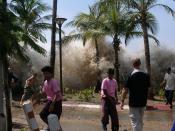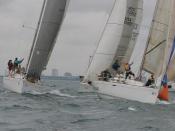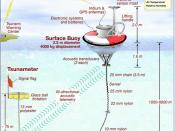TSUNAMIS
There are Earthquakes, Volcanoes, Floods, Fires and Avalanches. Then there are Tsunamis, The often overlooked stress relief system of the earth. Tsunamis are huge waves often called Tidal Waves but they have nothing to do with the diurnal pattern of high and low tides.
Tsunami is a Japanese word used as the scientific term for seismic sea wave, a large ocean wave caused by an undersea earthquake.
One theory is that the waves are triggered when the ocean floor is tilted or offset during an earthquake. Another possible cause is an undersea landslide or volcanic eruption. Most tsunamis originate along the so-called Ring of Fire, a ring of volcanoes and seismic activity, 32,500 km long, on the edge of the Pacific Ocean. Since 1819, about 40 tsunamis have struck the Hawaiian Islands.
A Tsunami may travel hundreds of kilometres across the deep ocean, reaching speeds of about 725 to 800 km/hr.
They have known to be seen out running airliners. This may be hard to believe but the wave may have been only about half a metre high out at sea, then suddenly begins growing rapidly as it creeps toward shore. By the time it reaches the shore, it may become a towering wall of water 15 m -35 m (50-115 feet) high or more, capable of destroying entire coastal settlements.
A famous Tsunami was the Chilean Tsunami which occurred on May 22, 1960. An earthquake occurred off the coast of South Central Chile.
A Pacific-wide tsunami was triggered by the earthquake. The number of fatalities associated with both the tsunami and the earthquake has been estimated to be between 490 and 2,290. Damage cost estimates were over a half billion dollars.
The information below is quite different from the thoughts and views of the public on Tsunamis,


